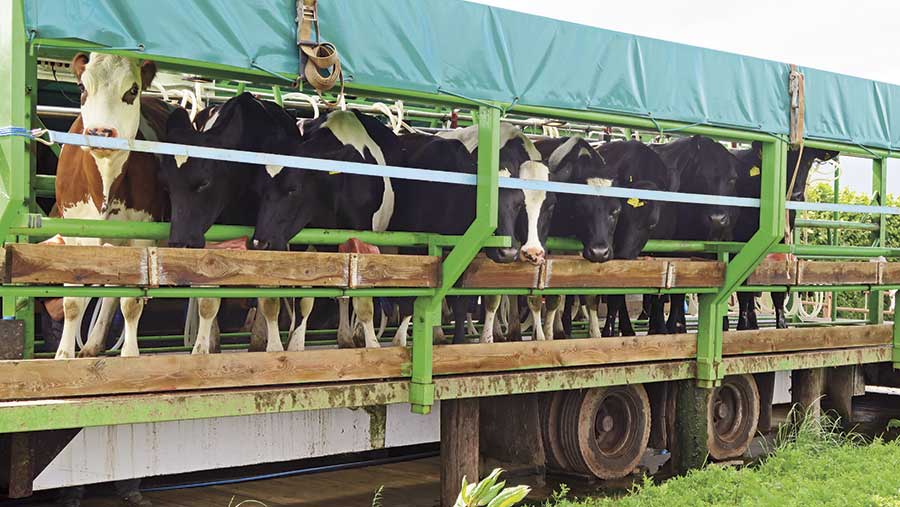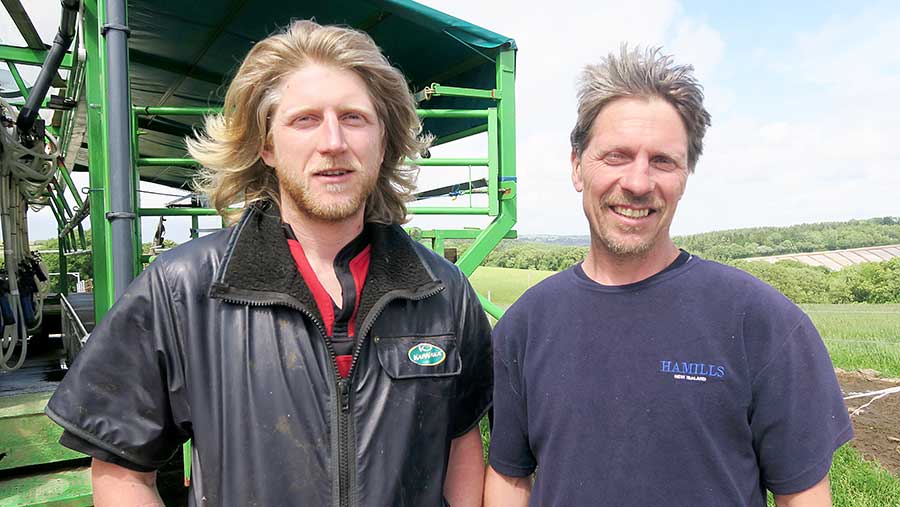Brothers build mobile dairy to achieve farming dream

Two brothers who had a lifelong ambition to milk their own cows, but no parlour or buildings, have finally achieved their goal by constructing their own mobile dairy unit.
Wayne Saunders and stepbrother Elliot Prettejohn from Chulmleigh, Devon, have spent much of their career milking cows for other people, but always had a yearning to run their own herd.
Inspired by a stint of share-milking in New Zealand, Wayne and Elliot returned to the UK in 2007, more determined than ever to start up their own farming business.
Wayne purchased 8ha of pasture, and he and Elliott began renting any blocks of land that became available within reasonable distance of the family base in mid-Devon.
The brothers ran a flock of 1,000 ewes in an extensive system, but two years ago they took the decision to switch to dairy production to achieve their ambition.
See also: Cows milked by robots are calmer, research suggests
Inspiration
Wayne recalls that the plan started to take shape when he and elliott were sitting in a field having lunch.
“I said what an incredible dairy farm it would make. But with no sheds, cows or a milking parlour, it would have been impossible for us to set up a conventional dairy system,” he says.

Wayne Saunders and Elliot Prettejohn from Chulmleigh, Devon designed and constructed the mobile parlour
“This is when the idea of a portable milking parlour first came up. As well as enabling us to start milking cows at a fraction of the cost compared with a fixed setup, we could easily relocate if needed – a vital option given the land is rented on short-term tenancies,” he says.
While they were confident they could run a profitable business by operating a simple, low-input grass-based system, there were many obstacles in getting the dairy unit up and running.
Determination
“It has required an enormous amount of determination,” explains Wayne. The first major obstacle was getting the approval from each of the brothers’ four landlords.
Running cows rather than sheep on the land was a significant change and was originally met with hesitation from landlords. But after explaining their vision, Wayne and Elliot secured the backing they needed.
“The next step was to secure a milk contract. This didn’t prove as easy as we first thought. Initially we approached conventional milk buyers, but with a lack of contracts available, this wasn’t really an option,” Wayne explains.
Going organic
“However, with the land already being farmed extensively with very little inputs, we decided to explore the organic sector and were offered a contract with the Organic Milk Suppliers Cooperative [OMSCo], the UK’s largest organic milk supplier.”
Producing organic milk delayed their plans due to the time required to convert the land to organic status.
But they were confident the partnership with OMSCo would provide long-term security for the business and embarked on a 20-month-long organic conversion period.
The business then critically hinged on funding, explains Elliot. “While the planned sale of the sheep would fund a proportion of the new venture, we still required significant support from the bank and had a lack of assets.
“After switching banks and presenting a solid business plan, we eventually managed to get an unsecured loan of £140,000.”
Business overview
- 140ha of tenanted permanent grassland, comprising several different blocks including a 150-acre block where the mobile parlour and milking cows are located
- Only permanent infrastructure is a concrete pad to site the mobile parlour and holding pens, and cow tracks
- Outdoor milking 140 cross-bred cows twice a day
- Spring block-calving with cows calving outdoors
- Grass-based New Zealand-style system
- Milk yield averages 16 litres a cow a day, with butterfat at 3.97% and protein at 3.18% (all heifers and produced 100% from grass)
- All milk sold to OMSCo with 450,000 litres anticipated to leave the site this year. This is expected to increase as yields naturally lift and herd size increases with further capacity to milk 30 extra cows
- Cows and the parlour will be moved to rented buildings for the winter period, where home-grown grass silage will be fed
- Calves fed outdoors using a self-made portable milk feeder
Sheep sold
“The sheep were gradually sold last spring with lambs at foot and the process of restocking with cows began. It made sense for us to purchase youngstock because, until the organic conversion process was complete, we couldn’t produce certified organic milk. We therefore bought in 12-month-old cross-bred dairy heifers, which were calved down aged about 24 months this spring,” says Elliot.
The loan, coupled with the sale of the sheep, have funded the entire start-up of the business, as well as subsidising Wayne and Elliot’s own living expenses during the difficult period when their income stopped.
In total, the brothers say it has cost about £200,000 to build the portable parlour and associated milking system along with the bulk tank and generator to power it.
The sum also covers a concrete pad to site the parlour and holding pens, the installation of cow tracks and the purchase of 140 12-month-old, cross-bred dairy heifers.
Mobile parlour design
The unit itself is built on top of a double-axled trailer using welded steel struts to support a tarpaulin roof. The sides unbolt and fold flat on to the trailer bed for transport. All of the welding work and design was carried out by Wayne and Elliot.
Access to the parlour is via ramps at the back end of the trailer and the first cows went through in March this year, with the system working well.
“The cows pass through the parlour easily and we can milk 100 cows an hour. We haven’t had any cows with mastitis, with somatic cell counts averaging 200,000/ml and no issues with lameness,” says Elliot.
While the brothers are sure they will undoubtedly come across problems, as in all dairy systems, they feel confident about the future and emphasise that thanks must go to everyone who has supported them so far, including their neighbours and milk partner OMSCo.
Parlour design and build
Wayne and Elliot Prettejohn designed and constructed the portable milking parlour. The process took three months in total and while challenging and time-consuming, the financial saving was significant, with the purchase of a similar portable parlour costing about £50,000 more.
Parlour details
- Double 15-herringbone parlour fitted out with a direct to line milking system
- Folds down on to a standard 2.4m-wide trailer for ease of transport
- Front mangers for feeding (currently just salt licks provided)
- Tarpaulin roof
- A generator and bulk tank is located in an adjacent shipping container
- Self-built with professional help only required to install the milking lines and the bulk tank
- Cost a total of £60,000 for the parlour, milking system and bulk tank
